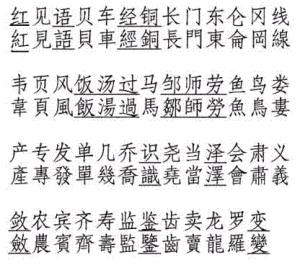Verbal
The Chinese is language is one the most ancient and complex in the world. It is officially the oldest written language in the world with a history spanning at least six thousand years. The Chinese alphabet is made of upwards of 40,000 characters which represent sounds and are used in sequence to make up words.
There are many dialects of Chinese, but only three are spoken widely throughout the country. The most common by far is Mandarin Chinese, which is the official dialect of China, and is the language taught in almost all Chinese schools and used on TV and in the media. Most Americans who learn Chinese choose to study Mandarin because of its prevalence in Chinese culture.
Cantonese is the second-most common dialect, and is used widely in Hong Kong, Guangdong, and southern Guangxi Zhuang. Because of this large regional concentration, many Chinese immigrants and expatriates to the nearby regions of the pacific coast of the United States (Washington, Oregon, and California) speak Cantonese.
Toisanese, another dialect, emerged from the Guangdong region. It is not nearly as commonly heard as Mandarin or Cantonese, and is not used in the media.

Simplified written Chinese (bottom lines) uses less pen strokes and lines than traditional (top lines). www.quora.com
Though the verbal languages cannot be universally understood by all Chinese, the written language can be understood by all who understand Chinese. The written form consists of characters which are simplified, traditional, and phonetic or slang. Simplified characters are condensed versions of traditional and classical Chinese characters, and use less pen strokes.
There also exists a form of “English Chinese” in which Chinese sounds and words are written phonetically in the roman alphabet to be better understood and learned by foreign speakers. This written form is often seen in fortune cookies.
Unlike English and romantic languages, verbs, nouns, or adjectives do not have to agree with each other in tense in Chinese. Additionally, there does not exist plural and singular forms of words. Instead a number is added to the sentence to tweak the meaning.
The Chinese language is so complex and vastly different than many other languages that translation and interpretation proves an extremely difficult task, and translators must keep in mind not only literal meaning but cultural differences and how the different languages represent differing worldviews of the two cultures.
Non-Verbal
China is considered, like many other Asian countries, to possess a more collectivist and low-contact culture than that of the United States, making their nonverbal communication different than, and sometimes in conflict with American nonverbal behavior. However, there is evidence in all areas of China of westernization and changing cultural norms, the area of nonverbal communication being no exception. Though we can classify many nonverbal norms in China as the result of a collectivist low-contact lifestyle, we must acknowledge that differences exist regionally and personally in such a large country.
The Chinese and other East Asian cultures are known to place the most emotional importance on the eyes when expressing and recognizing emotions. According to one study, “Western Europeans fixate more on the mouth region, and East Asians fixate more on the eye region when recognising facial expressions.” In the Chinese culture, information and nonverbal cues are communicated through the eyes rather than through expressive smiles or frowns which Western cultures and Americans use to communicate.
However, it is also true that direct and prolonged eye contact is avoided in China. Chinese and East Asian individuals have been said to “perceive another’s face as angrier and more unapproachable and unpleasant when making eye contact as compared to individuals from a Western European culture.”
There are a few specific gestures which hold different meaning in China than in other cultures. Placing the forefinger to the lips and creating a “shah” or “shh” sound resembles hissing and represents disapproval in China, more severe than its meaning of silence in the United States and other Western cultures. Additionally, to beckon someone to approach you in China, the gesture is a hand extended toward the person with the palm down, moving the fingers back and forth. This is often confusing to Americans, as it appears as if the person is waving goodbye. The American beckoning gesture, an upward-facing palm with the index finger moving back and forth, is considered offensive in China as they avoid pointing with one finger.
Although attitudes toward physical contact and spatial difference are gradually becoming less low-contact in China and other Asian countries, affectionate touching and public displays of affection remain very different compared to western cultures. A study concluded that “Asian couples were far less likely to walk with arms around one another than were Latino couples.” Generally, close contact is avoided in public and touching is kept to a minimum in China, especially in business and professional situations. However, handshakes are an accepted form of greeting and are commonly used during introductions and business meetings.

